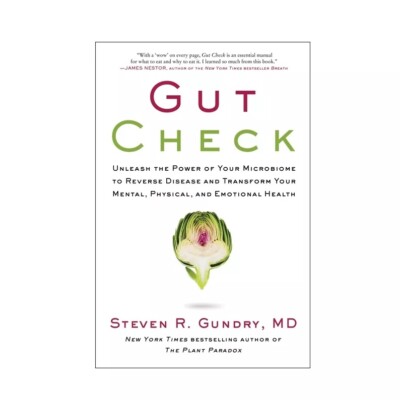It’s true for nearly all wellness buzzwords: we may hear it everywhere, but how quickly can we actually define the term? (Without sneaking a glance at our phone.) Colostrum, probiotics, and yes—gut health. Knowing this, the Camille Styles team has taken it upon ourselves to interview experts on the cutting edge of every wellness trend. And as a result, give our readers the clarity they deserve. Today, we sat down with Dr. Steven Gundry to discuss all things gut health—and why prioritizing it can be the key to optimal well-being.
Featured image from our interview with Roxana Saidi by Suruchi Avasthi.
Dr. Steven Gundry on His New Book, Gut Check—and How to Maintain a Healthy Microbiome
Because our gut is the control center for nearly all of the body’s systems and processes, we take supporting it seriously. From microbiome-boosting foods to the lifestyle habits that impact it, where wellness is concerned, gut health is always top of mind. And when it comes to the trending topic, no one’s more qualified to speak on it than Dr. Steven Gundry. Having worked in medicine for over 40 years as a cardiothoracic surgeon and heart surgeon, the MD has adopted a proactive focus, stating his mission “to improve your health, happiness, and longevity by making simple changes to your diet.” And in his latest book, Gut Check, Dr. Gundry makes a convincing argument for his holistic approach.
Read on for our conversation with Dr. Gundry, in which he outlines actionable tips for improving gut health, his take on supplementation, and the first two steps to take on your healing journey. And be sure to scroll to the end for his go-to snack cake recipe. Bonus: It’s a mainstay in his Gut Check food plan.

Steven Gundry MD, F.A.C.S., F.A.C.C., is a cum laude graduate of Yale University with special honors in Human Biological and Social Evolution. After graduating Alpha Omega Alpha from the Medical College of Georgia School of Medicine, Dr. Steven Gundry completed residencies in General Surgery and Thoracic Surgery at the University of Michigan and served as a Clinical Associate at the National Institutes of Health for years. Dr. Gundry is the author of numerous books, including Dr. Gundry’s Diet Evolution, The Plant Paradox, The Plant Paradox Cookbook, and his latest, Gut Check.


Can you distill gut health to its core definition and highlight why we should prioritize it?
25 hundred years ago, Hippocrates, the father of medicine, said that all disease begins in the gut. I’ve spent the last 25 years finding out how right he was!
The complex ecosystem of bacteria, fungi, and worms (yes, worms) that live in our intestines (the microbiome) communicates via a “language” to all cells in our body and controls most functions that we take for granted, even our emotions and hormones. We have systematically starved and poisoned this integral partner of our health with antibiotics. [Ones] that we take, or that are fed to animals that we eat, or are sprayed on so many of our grain crops.
Furthermore, as the saying goes, “Good fences make good neighbors.” As much as we are dependent on our microbiome, they need to stay on their side of the gut wall—a single-cell thick layer that has the same surface area as a tennis court. When this wall is damaged, it results in “leaky gut,” which allows food particles and bacteria to pass through the fence, resulting in inflammation. [My book] Gut Check shows how this happens to most of us and how to fix it.
Looking for more gut-friendly habits to improve your health? Check out this guide.


Once someone commits to healing their gut, how long does it take to experience true transformation? What would that look and feel like?
For most of my patients, it takes 6-12 months to heal leaky gut and to restore the complex gut microbiome diversity. We can measure these changes using simple blood tests and watch the progress. Thankfully, within a couple of weeks, most patients notice important changes in how they feel, their bowel movements, their mood, etc.
You explain that it’s not what we eat, but our ability to digest and process beneficial nutrients that matters. What are concrete, actionable ways we can improve our body’s processing system?
After 25 years of measuring these changes every 3 months in my patients, I can say that removing wheat, rye, barley, oats, corn, and other pseudo-grains from the diet is a great start. 100% of my patients with leaky gut have antibodies to the various components of wheat and grains. By following this program, these issues are resolved and disappear.


You write that “working closely with my patients to restore their gut biome and gut wall leads to remarkable health transformations, healing […] Alzheimer’s disease and dementia […].” To confirm, are Alzheimer’s and dementia reversible through healing the gut?
There is increasing evidence that memory loss, Alzheimer’s, Parkinson’s, and neuropathy begin in the gut. As I write in the book, “leaky gut equals leaky brain!” In my experience, there is a point where these changes can be stopped and reversed if caught early enough, but sadly, less is possible the longer treatment is delayed.
You offer a comprehensive Gut Check Food Plan. Is this indicative of an ideal eating plan if healing your gut is your goal? How much “wiggle room” is there to stray from the plan while still keeping your gut generally healthy?
My food plan reflects what I’ve learned from my patients’ habits and blood work over the past 25 years. While I have many very motivated and “perfect” patients, most, including myself, stray from time to time. So, the less you “cheat,” the faster you heal.


What is your stance on prebiotic and probiotic supplementation? Do you have favorite brands/products for supporting gut function?
I have learned that there are multiple ways to restore the gut ecosystem including probiotics and prebiotics. But what surprises most people is that it’s the postbiotics primarily from fermented foods that make the real difference. In other words, plain yogurts and kefirs, low-sugar kombucha, vinegars, black coffee, tea, and even extra-dark chocolate, red wine, and aged cheeses are all great sources of postbiotic-containing foods.
What surprises most people is that it’s the postbiotics primarily from fermented foods that make the real difference.
Your book comprehensively covers the process of healing your gut. How would you encourage someone to take to begin this journey in the most efficient, optimized way?
Two simple steps: maximize your Vitamin D3 intake to at least 5,000-10,000 IUs a day, and remove grains and pseudo-grains from your diet. And, for more dos and don’ts, follow the “yes please” and “no thank you” lists in Gut Check.
Pick up Gut Check wherever books are sold—and keep reading for the gut-healing snack cake Dr. Gundry swears by.
Print
Chocolate Goat Milk Yogurt Snack Cake with Pistachio Butter Drizzle
- Yield: Serves 8 to 10 1x
Description
I think the trend of snack cakes—single-layer cakes with a fun drizzle or frosting—is fantastic. It means that you always have a dessert on hand or something to serve guests. And this snack cake bakes so easily, it’s the perfect thing to make on a weeknight—or whenever a sugar craving strikes.
Ingredients
for the cake:
- Olive oil spray
- 2 large pasture-raised eggs
- 1/2 cup unsweetened goat milk yogurt
- 1/2 cup allulose
- 1 1/2 teaspoons vanilla extract
- 1 1/2 teaspoons almond extract
- 1 cup blanched almond flour
- 1/2 cup natural unsweetened cocoa powder
- 1/4 teaspoon iodized sea salt
- 1/2 teaspoon baking soda
for the drizzle:
- 1/4 cup pistachio butter
- 1/4 cup unsweetened goat milk yogurt
- 1/8 cup allulose
- 1/4 teaspoon ground cinnamon
- Zest of 1 orange or tangerine
Instructions
- Preheat your oven to 325 F. Grease an eight-inch cake pan with olive oil spray and set aside.
- In a large bowl, whisk together the eggs, yogurt, allulose, vanilla extract, and almond extract.
- In another bowl, whisk together the almond flour, cocoa powder, salt, and baking soda. Fold the dry ingredients into the wet ingredients and stir until well combined. Pour the batter into the prepared cake pan. Bake at 325 F until a toothpick inserted into the center of the cake comes out clean, 30 to 35 minutes. Remove from the oven and let cool.
- While the cake is cooling, make the drizzle: Whisk together the drizzle ingredients and keep stirring until the allulose has melted into the mixture and is no longer granular. Drizzle over the room temperature cake and serve.
- Store the leftovers (if there are any!) in the fridge for up to 5 days.
Recipe image by Claudia Curici.






